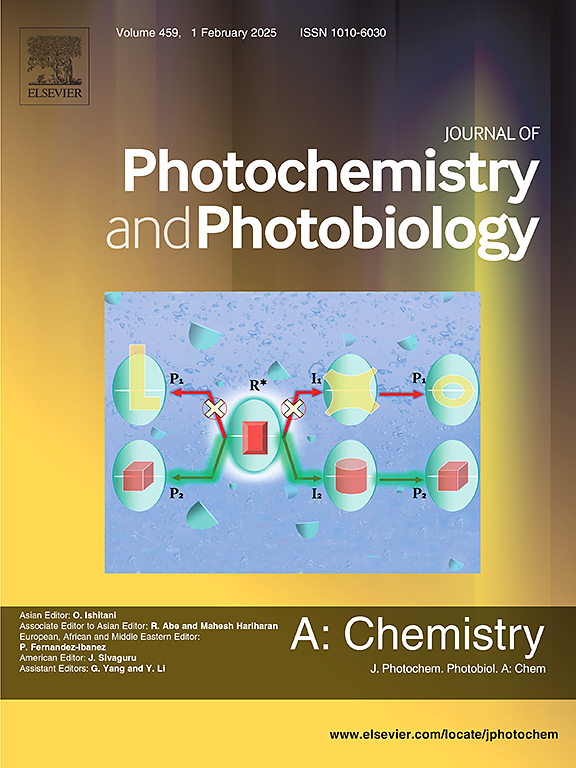Fabrication and characterization of co-sensitized dye solar cells incorporating cyclodextrin functional layers with energy transfer from spiropyran derivatives to SQ2 dye
IF 4.7
3区 化学
Q2 CHEMISTRY, PHYSICAL
Journal of Photochemistry and Photobiology A-chemistry
Pub Date : 2025-06-06
DOI:10.1016/j.jphotochem.2025.116531
引用次数: 0
Abstract
We developed dye-sensitized solar cells (DSSCs) using the sensitizing dye 1,5-carboxy-2-[[3-[(2,3-dihydro-1,1-dimethyl-3-ethyl-1H-benzo[e]indol-2-ylidene)methyl]-2-hydroxy-4-oxo-2-cyclobuten-1-ylidene]methyl]-3,3-dimethyl-1-octyl-3H-indolium (SQ2) and the photochromic molecule 1,3,3-trimethyl indolino-6′-nitrobenzopyrylospiran (SPNO2). DSSCs incorporating photochromic molecules can regulate photoelectric conversion efficiency (η) through external light irradiation. To enhance η, cyclodextrins (CDs) (α-CD, β-CD, γ-CD) were introduced. Among them, γ-CD improved η from 1.2 % to 1.5 % by suppressing SQ2 aggregation. The color of the SQ2/CDs/SPNO2-containing photoelectrode changed from blue to purple under UV irradiation and from purple to green under visible light. The η of DSSCs increased after UV irradiation and decreased under visible light. However, direct electron injection from the photochromic molecule appeared to be challenging, suggesting that the efficiency enhancement was primarily due to Förster resonance energy transfer (FRET) from SPNO2 to SQ2. FRET efficiency calculations showed that β-CD exhibited the highest efficiency among CDs. These findings indicate that the co-sensitization of DSSCs by SPNO2-SQ2 and SQ2 alone, facilitated by their respective photoabsorption properties, enables externally tunable photoelectric conversion. This study provides insights into high-performance DSSCs with tunable efficiency through CD inclusion effects and photochromic molecular energy transfer, contributing to solar energy advancements.

含有环糊精功能层并能从螺吡喃衍生物转移到SQ2染料的共敏化染料太阳能电池的制备和表征
我们利用增敏染料1,5-羧基-2-[[3-[(2,3-二氢-1,1-二甲基-3-乙基- 1h -苯并[e]吲哚-2-酰基)甲基]-2-羟基-4-氧-2-环丁基-1-酰基]甲基]-3,3-二甲基-1-辛基- 3h -吲哚(SQ2)和光致变色分子1,3,3-三甲基吲哚-6 ' -硝基苯并吡啶(SPNO2)制备了染料敏化太阳能电池(DSSCs)。含有光致变色分子的DSSCs可以通过外部光照射调节光电转换效率(η)。为了提高η值,引入环糊精(α-CD, β-CD, γ-CD)。其中,γ-CD通过抑制SQ2聚集使η值从1.2%提高到1.5%。含SQ2/CDs/ spno2光电极的颜色在紫外照射下由蓝色变为紫色,在可见光下由紫色变为绿色。紫外辐照后DSSCs的η增大,可见光下η减小。然而,从光致变色分子中直接注入电子似乎是具有挑战性的,这表明效率的提高主要是由于Förster共振能量转移(FRET)从SPNO2到SQ2。FRET效率计算表明,β-CD在CDs中效率最高。这些发现表明,由于SPNO2-SQ2和SQ2各自的光吸收特性,DSSCs的共敏化可以实现外部可调的光电转换。该研究通过CD包合效应和光致变色分子能量转移,为研究具有可调效率的高性能DSSCs提供了新的见解,为太阳能的发展做出了贡献。
本文章由计算机程序翻译,如有差异,请以英文原文为准。
求助全文
约1分钟内获得全文
求助全文
来源期刊
CiteScore
7.90
自引率
7.00%
发文量
580
审稿时长
48 days
期刊介绍:
JPPA publishes the results of fundamental studies on all aspects of chemical phenomena induced by interactions between light and molecules/matter of all kinds.
All systems capable of being described at the molecular or integrated multimolecular level are appropriate for the journal. This includes all molecular chemical species as well as biomolecular, supramolecular, polymer and other macromolecular systems, as well as solid state photochemistry. In addition, the journal publishes studies of semiconductor and other photoactive organic and inorganic materials, photocatalysis (organic, inorganic, supramolecular and superconductor).
The scope includes condensed and gas phase photochemistry, as well as synchrotron radiation chemistry. A broad range of processes and techniques in photochemistry are covered such as light induced energy, electron and proton transfer; nonlinear photochemical behavior; mechanistic investigation of photochemical reactions and identification of the products of photochemical reactions; quantum yield determinations and measurements of rate constants for primary and secondary photochemical processes; steady-state and time-resolved emission, ultrafast spectroscopic methods, single molecule spectroscopy, time resolved X-ray diffraction, luminescence microscopy, and scattering spectroscopy applied to photochemistry. Papers in emerging and applied areas such as luminescent sensors, electroluminescence, solar energy conversion, atmospheric photochemistry, environmental remediation, and related photocatalytic chemistry are also welcome.

 求助内容:
求助内容: 应助结果提醒方式:
应助结果提醒方式:


